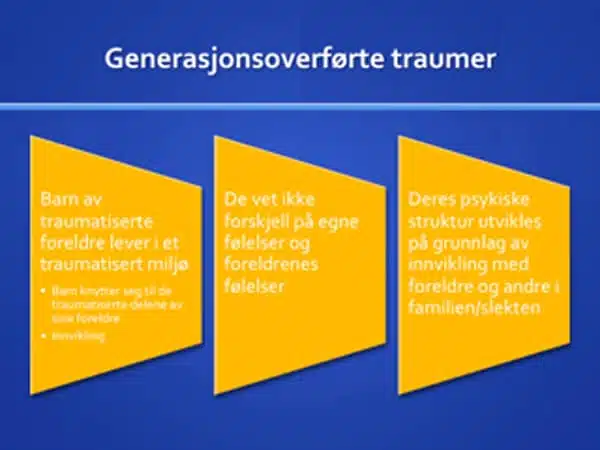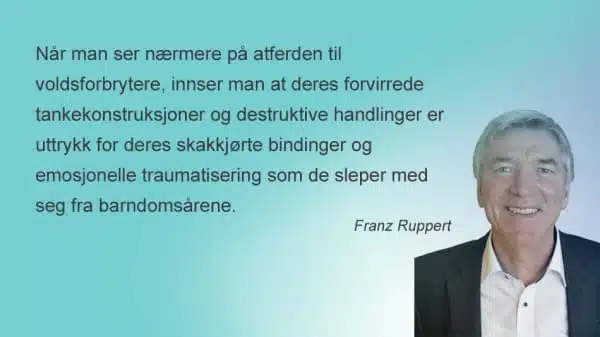Mental disorders can be caused by trauma in previous generations.
Marta Thorsheim is a therapist, and has edited the book "Understand your wounds in the soul" by Franz Ruppert. She talks about the way out of complex mental disorders.
Sometimes panic attacks, depression or the like can come as a surprise. Apparently, the victim has had a trauma-free life. The German professor and therapist Franz Ruppert gives a fascinating explanation of the phenomenon. A person's mental health problems can be caused by entanglement in relationships that go back a long way. Therefore, diagnosis must include the patient's family system.
The best therapy children can get is for parents to resolve their own traumas and entanglements. Traumatized mothers can transfer their experience through interaction with their children. The children become active, but inappropriate, participants in the mother's attempts to find meaning and peace. Children can feel their parents' repressed emotions, such as the fear of being exposed, guilt and shame. Around 80 percent of children with traumatized parents show such traumatized attachment patterns. They may experience overwhelming emotions without knowing the traumatic event that would have given the emotions meaning.
How does Franz Ruppert explain a psychosis?
Psychosis is not only an escape from reality, but also an attempt to find creative solutions to major life crises. By understanding psychosis as a coping strategy, victims and helpers can more easily uncover the potential for recovery. A psychosis thus becomes a strategy for surviving after traumatic experiences. It can be self-experienced trauma or trauma that has been passed down through generations.
Strategies for coping and survival thus become unhealthy reactions, even if they feel necessary. How can the dilemma be resolved?
In most cases, mental health problems are not to blame. Once a psychological split is established, decisions are often made that make the condition worse or harm others. In order to get on the right track, one must want to continue on this path - consistently. Survival strategies will constantly call the decision into question and threaten endurance, with their tricks and excuses.
Getting out of survival mode is often tiring at first. Therefore, recovery can be slow. Experienced therapists are needed who anticipate the inner struggle and support the patient's healthy parts. Coping strategies may pretend to be reasonable, but good therapists can expose them. It is important to have methods that can grasp the complexity of the psychological processes, and not just focus on certain aspects. Here, Ruppert's constellation method has huge advantages, in my opinion.
What is the constellation method?
It is not just a single therapist trying to understand the confusing connections in a person's psyche. The therapist, who is called a constellator, asks the client to choose representatives of events, sub-personalities, people and other things that may lie behind those problems. The representatives are people who participate in groups. With their help, hidden feelings and dynamics become something concrete that the client can relate to. The client can get in touch with repressed feelings and process them.
The psyche may insist that nothing traumatic has happened, and hold on to illusions. Constellations can provide access to stored, wordless memories. In addition, they provide a supportive environment from other participants in the constellation seminars. As individual therapy, constellations work in the same way, but instead of representatives, for example, figures are used to clarify fragmented parts of the psyche. The constellator can also use himself as a representative, and the client himself can represent the various elements in a constellation. Again, the entire therapy process is a mutual collaboration between therapist and client.
How widespread is such therapy in Norway?
Norway currently has approximately 100 Constellators/trauma therapists. There are over 100 members in the Norwegian Constellators' Association. The German psychotherapist Bert Hellinger learned about constellations in the United States. He took the method with him to Germany, further developed it and made it known all over the world. After Hellinger, the method has been developed in many directions. Franz Ruppert combines two theoretical building blocks and a practical method:
1. The theory of attachment
2. The trauma tour
3. The practical method constellations
What is the downside of trying to medicate mental disorders?
The disadvantage is that the feelings are adjusted artificially, and most often without the suffering disappearing. Such medications can also have major side effects. In my opinion, medication is sometimes necessary, but preferably in combination with processing underlying trauma.
Why can't time heal the wounds when it comes to trauma?
It's a good question, but experience shows that trauma repeats itself. A bodily reaction that is usually time-limited stops when you are traumatized. It is therefore not completed. It often leads to both physical and psychological symptoms. These are often confusing and frightening. The feelings are suppressed, but they don't go away. They are stored in the part of the psyche or soul that Dr. Ruppert calls "the traumatized part".
Then survival strategies are developed. The repressed feelings would like to emerge. Something in us believes that if we only experience something that can evoke these feelings, the stored reaction will be able to be completed. But it doesn't get better even if we experience trauma after trauma. It gets increasingly worse if the feelings are not processed so that the body's reaction pattern can "trigger" the stored reactions.
In order to heal a trauma, then, we must trigger and complete the physical fight-or-flight energies that were mobilized to meet a danger. This happens by bringing the client into contact with the repressed feelings in a constellation. Often he or she gets a bodily reaction, such as freezing and trembling. It is the same thing that happens automatically in a traumatic situation, but then it becomes too much for us. It is shifted to the subconscious. A trauma can be anything that overwhelms our ability to cope with a situation. Therefore, young children are most at risk.








